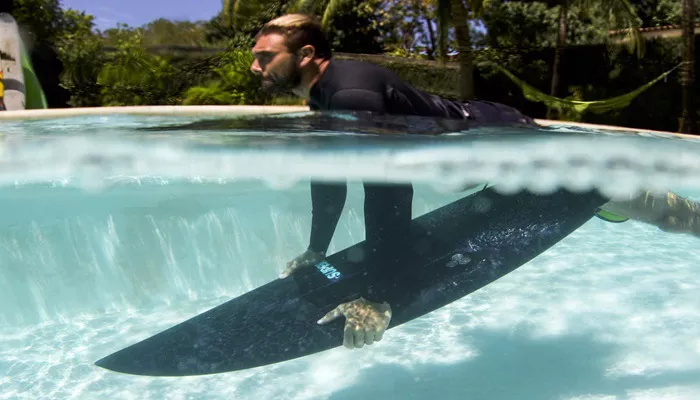Surfing is one of the most exhilarating water sports, but it comes with challenges that every surfer must overcome. One of the most common problems, especially for beginners, is nose diving. Nose diving occurs when the front of the surfboard sinks into the water, causing the surfer to fall forward. This can be frustrating, but with the right techniques and adjustments, it can be avoided. In this guide, we’ll explore the causes of nose diving and how to prevent it, ensuring a smoother and more enjoyable surfing experience.
What Causes Nose Diving in Surfing?
Before learning how to prevent nose diving, it’s crucial to understand what causes it. Here are the main reasons surfers experience this problem:
Incorrect Weight Distribution – Placing too much weight on the front of the board causes the nose to dip into the water.
Poor Paddling Technique – Inefficient paddling can result in catching waves too late or at the wrong angle, increasing the risk of nose diving.
Bad Positioning on the Board – Lying too far forward on the surfboard can cause the nose to submerge when catching a wave.
Taking Off Too Steeply – If you try to take off on a wave that is too steep, the board’s nose may plunge directly into the water.
Lack of Speed Control – Not managing speed properly when catching a wave can lead to an uncontrollable drop, increasing the likelihood of a nose dive.
Now that we understand the causes, let’s explore practical techniques to prevent nose diving.
1. Adjust Your Position on the Surfboard
Finding the right position on your surfboard is crucial to maintaining balance and preventing nose diving. Here’s how to position yourself correctly:
Lie in the Sweet Spot – The sweet spot is where the board remains flat in the water while paddling. If the nose is too high, move slightly forward; if it dips, move slightly backward.
Keep Your Chest Lifted – Lifting your chest slightly while paddling prevents the board’s nose from sinking.
Check Your Foot Placement – When standing up, distribute your weight evenly and avoid leaning too far forward.
2. Improve Your Paddling Technique
Efficient paddling ensures you catch waves properly and reduces the chance of nose diving. Follow these tips for better paddling:
Use Deep, Strong Strokes – Paddling with long and deep strokes increases speed and stability.
Look Ahead, Not Down – Keep your head up and look at where you want to go to maintain balance.
Time Your Paddle Correctly – Start paddling early and match the wave’s speed to ensure a smooth takeoff.
3. Angle Your Takeoff on Steep Waves
Taking off directly down a steep wave can result in nose diving. Instead, try these adjustments:
Angle Your Board Slightly – Instead of taking off straight down, angle your board slightly toward the wave’s shoulder.
Pop Up Quickly – A delayed pop-up can make the nose sink. React fast to keep control of your board.
Use Your Back Foot – Apply pressure to your back foot while taking off to keep the nose from dipping too much.
4. Master the Pop-Up Technique
A proper pop-up is essential for preventing nose diving. Follow these steps:
Push Up Firmly – Use your hands to push your upper body off the board.
Swing Your Feet Under You – Move both feet quickly to their proper stance position.
Stay Centered – Keep your weight balanced to avoid excessive pressure on the front of the board.
5. Control Your Speed
Managing speed is key to preventing nose diving. Try these techniques:
Apply Pressure on the Tail – Lean slightly back to keep the nose lifted when needed.
Adjust Your Stance – Widening your stance gives better control over speed and balance.
Use Small Carves – Making small turns helps regulate speed and keeps the board from sinking too quickly.
6. Choose the Right Surfboard
The type of surfboard you use affects your ability to avoid nose diving. Consider the following:
Larger Boards Provide Stability – Beginners should use longer, wider boards for better balance.
Rocker Shape Matters – A board with more rocker (curvature) reduces the chances of nose diving.
Right Volume for Your Weight – Choose a board with enough volume to support your weight without sinking too much.
7. Practice in Small Waves
If you’re struggling with nose diving, practice in smaller, gentler waves to refine your technique. Focus on:
Perfecting Your Positioning – Make small adjustments until you find the most balanced stance.
Improving Your Timing – Work on catching waves earlier to prevent late takeoffs.
Gaining Confidence – Smaller waves provide a safer environment to practice without heavy wipeouts.
Conclusion
Nose diving is a common challenge in surfing, but with the right techniques and adjustments, it can be significantly reduced. By refining your board positioning, improving paddling and takeoff techniques, managing speed, and choosing the right surfboard, you can enjoy a smoother and more controlled surfing experience. Practice these strategies consistently, and soon, nose diving will be a thing of the past. Happy surfing!

